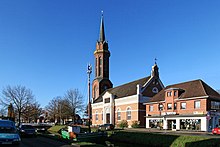Westrhauderfehn
|
Westrhauderfehn
municipality Rhauderfehn
|
|
|---|---|
| Coordinates: 53 ° 7 ′ 26 ″ N , 7 ° 33 ′ 4 ″ E | |
| Height : | 3 m above sea level NHN |
| Area : | 16.88 km² |
| Residents : | 7610 |
| Population density : | 451 inhabitants / km² |
| Incorporation : | 1st January 1973 |
| Postal code : | 26817 |
| Area code : | 04952 |
|
Location of the municipality of Rhauderfehn in the district of Leer
|
|
Westrhauderfehn has been the largest part of the new municipality of Rhauderfehn since the administrative and territorial reform of January 1, 1973 . Today it has 7610 inhabitants. It is located about thirteen kilometers southeast of the district town of Leer in East Frisia . The around 16.88 km² area was founded on high moorland soil. It is separated from the neighboring village of Ostrhauderfehn by a narrow strip with a glazed floor .
history
The Emden merchants Johann Friedrich Heydecke and Thomas Stuart, the Stickhauser bailiff Rudolf von Glan , the receptor Ahlrich Ibelings from Breinermoor and the houseman Wille Janssen founded the association of entrepreneurs des Rhauderfehns on June 10, 1766 . On April 19, 1769, the Prussian King assigned this company 1500 diemat from the marshes in Overledingerland - Stickhausen , in which they initiated the settlement as a fen colony.
Initially, the main purpose of settlement was peat extraction. It was only later that the reclamation of the moor was turned to cultivated land. As in the other East Frisian Fehn towns, shipping developed into a further branch of business for the Fehntjer in the 19th century, alongside peat extraction and - mostly modest - agriculture. The basis of this profession was the independent removal of the peat to the sales areas, primarily the cities of Emden and Leer as well as the marshes. Since 1871 there was a Royal Prussian Navigation School in Westrhauderfehn . Around the turn of the century, steamships displaced the sailors from the Fehnen within a few years, and their shipping rapidly lost its importance. In 1918 the navigation school was closed.
Development of the place name
In 1824 the fen colony was officially called Rauder-Wester-Fehn , in 1848 Rhauder Westerfehn and in 1871 West-Rhauderfehn . The name is a combination of the place name Rhaude , the direction west and the word Fehn , which designates the type of settlement.
coat of arms
The coat of arms of the former municipality of Westrhauderfehn shows a golden anchor in blue with a knob on top and winged on both sides; two golden snakes wind around the stick. This combination of an anchor and a rod of Mercury stands for seafaring and trade. The coat of arms was designed in 1954 based on the former coat of arms of the Rhauder-Fehn-Compagnie. The municipality finally adopted the coat of arms in 1955. Since the administrative and territorial reform of January 1, 1973, the municipality of Rhauderfehn has carried the municipal coat of arms of Westrhauderfehn.
religion
The Evangelical Lutheran inhabitants were originally parish in Rhaude. In 1829 the community received its own pastorate.
Daughter of the place
- Tina Willms (* 1963), Protestant theologian and writer
Individual evidence
- ↑ a b c d Rhauderfehn.de: Westrhauderfehn , accessed on January 20, 2013.
- ^ Federal Statistical Office (ed.): Historical municipality directory for the Federal Republic of Germany. Name, border and key number changes in municipalities, counties and administrative districts from May 27, 1970 to December 31, 1982 . W. Kohlhammer GmbH, Stuttgart / Mainz 1983, ISBN 3-17-003263-1 , p. 262 .
- ^ Ortschronisten der Ostfriesischen Landschaft: Westrhauderfehn, Gemeinde Rhauderfehn, Landkreis Leer (PDF; 691 kB), accessed on January 20, 2013.
- ↑ Rhauderfehn.de: The coat of arms of the municipality of Rhauderfehn , viewed on January 20, 2013.
- ↑ Reimers: Westrhauderfehn . In: Philipp Meyer: The pastors of the regional churches of Hanover and Schaumburg-Lippes since the Reformation . Volume 2, Göttingen 1942, p. 499.


